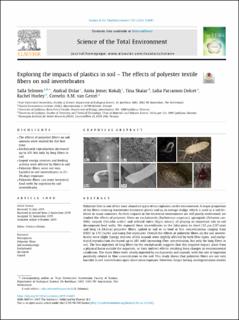| dc.contributor.author | Selonen, Salla | |
| dc.contributor.author | Dolar, Andraz | |
| dc.contributor.author | Kokalj, Anita Jemec | |
| dc.contributor.author | Skalar, Tina | |
| dc.contributor.author | Dolcet, Lidia Parramon | |
| dc.contributor.author | Hurley, Rachel | |
| dc.contributor.author | van Gestel, Cornelis AM | |
| dc.date.accessioned | 2020-09-22T11:57:35Z | |
| dc.date.available | 2020-09-22T11:57:35Z | |
| dc.date.created | 2020-09-08T16:24:01Z | |
| dc.date.issued | 2020 | |
| dc.identifier.citation | Science of the Total Environment. 2020, 700, 134451. | en_US |
| dc.identifier.issn | 0048-9697 | |
| dc.identifier.uri | https://hdl.handle.net/11250/2679035 | |
| dc.description.abstract | Polyester fiber is one of the most abundant types of microplastics in the environment. A major proportion of the fibers entering wastewater treatment plants end up in sewage sludge, which is used as a soil fertilizer in many countries. As their impacts in the terrestrial environment are still poorly understood, we studied the effects of polyester fibers on enchytraeids (Enchytraeus crypticus), springtails (Folsomia candida), isopods (Porcellio scaber) and oribatid mites (Oppia nitens), all playing an important role in soil decomposer food webs. We exposed these invertebrates in the laboratory to short (12 µm–2.87 mm) and long (4–24 mm) polyester fibers, spiked in soil or in food at five concentrations ranging from 0.02% to 1.5% (w/w) and using five replicates. Overall the effects of polyester fibers on the soil invertebrates were slight. Energy reserves of the isopods were slightly affected by both fiber types, and enchytraeid reproduction decreased up to 30% with increasing fiber concentration, but only for long fibers in soil. The low ingestion of long fibers by the enchytraeids suggests that this negative impact arose from a physical harm outside the organism, or from indirect effects resulting from changes in environmental conditions. The short fibers were clearly ingested by enchytraeids and isopods, with the rate of ingestion positively related to fiber concentration in the soil. This study shows that polyester fibers are not very harmful to soil invertebrates upon short-term exposure. However, longer lasting, multigeneration studies with functional endpoints are needed to reveal the possible long-term effects on soil invertebrates and their role in the decomposition process. This study also shows that polyester fibers can enter terrestrial food web via ingestion of fibers by soil invertebrates. | en_US |
| dc.language.iso | eng | en_US |
| dc.publisher | Elsevier | en_US |
| dc.rights | Attribution-NonCommercial-NoDerivatives 4.0 Internasjonal | * |
| dc.rights.uri | http://creativecommons.org/licenses/by-nc-nd/4.0/deed.no | * |
| dc.title | Exploring the impacts of plastics in soil - The effects of polyester textile fibers on soil invertebrates | en_US |
| dc.type | Peer reviewed | en_US |
| dc.type | Journal article | en_US |
| dc.description.version | publishedVersion | en_US |
| dc.source.pagenumber | 11 | en_US |
| dc.source.volume | 700 | en_US |
| dc.source.journal | Science of the Total Environment | en_US |
| dc.identifier.doi | 10.1016/j.scitotenv.2019.134451 | |
| dc.identifier.cristin | 1828192 | |
| dc.relation.project | Norges forskningsråd: 271825 | en_US |
| cristin.ispublished | true | |
| cristin.fulltext | original | |
| cristin.qualitycode | 2 | |

